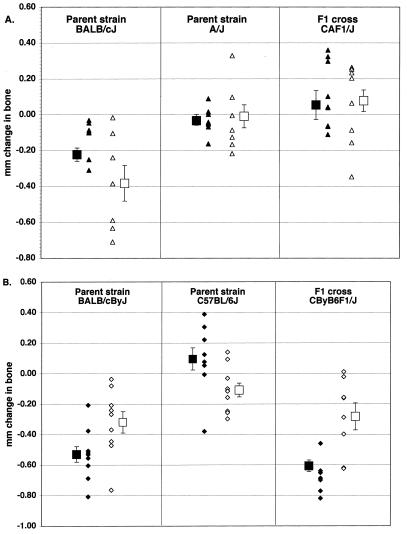FIG. 3.
Bone loss in P. gingivalis-infected F1 mice from two different crosses. Each symbol represents one infected mouse. Data from sham-infected mice are not shown. Open symbols and solid symbols are results from independent experiments. Squares with brackets represent the mean ± standard error of the respective experiments. (A) BALB/cJ × A/J cross. Infected mice of one parent strain (BALB/cJ) lost bone (different from BALB/cJ sham controls at P = 0.02 in one experiment P = 0.01 in the other, and P = 0.0006 for pooled data); infected mice of the other parent strain (A/J) and infected F1 mice (CAF1/J) did not lose bone (not different from sham controls; P > 0.05). Values from infected BALB/c mice differed from those from infected A/J mice (P = 0.031 in one trial, P = 0.028 in the other, and P = 0.0024 for pooled data). Infected BALB/cJ mice also differed from infected CAF1 mice (P = 0.0049 in one experiment, P = 0.0041 in the other, and P = 6 × 10−6 for pooled data). (B) BALB/cByJ × C57BL/6J cross. Infected mice of one parent strain (BALB/cByJ) and infected F1 mice (CByB6F1/J) lost bone. (Infected BALB/cByJ mice were different from BALB/cByJ sham controls at P = 7 × 10−6 in one experiment, P = 0.01 in the other, and P = 9 × 10−7 for pooled data; infected CByB6F1 mice were different from CByB6F1 sham controls at P = 5 × 10−7 in one trial, P = 0.04 in the other, and P = 2 × 10−5 for pooled data.) Infected mice of the other parent strain (C57BL/6J) mice did not lose bone (not different from sham controls, P > 0.05). Values from infected BALB/c mice differed from those from infected C57BL/6J mice (P = 2 × 10−7 in one trial, P = 0.04 in the other, and P = 3 × 10−7 for pooled data). Infected CByB6F1/J mice also differed from infected C57BL/6J mice (P = 3 × 10−8 in one trial, P = 0.05 in the other, and P = 3 × 10−6 for pooled data).

